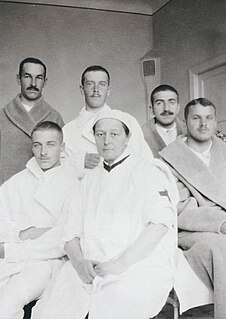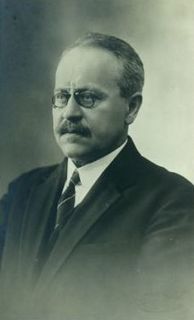Related Research Articles

Infographics are graphic visual representations of information, data, or knowledge intended to present information quickly and clearly. They can improve cognition by utilizing graphics to enhance the human visual system's ability to see patterns and trends. Similar pursuits are information visualization, data visualization, statistical graphics, information design, or information architecture. Infographics have evolved in recent years to be for mass communication, and thus are designed with fewer assumptions about the readers' knowledge base than other types of visualizations. Isotypes are an early example of infographics conveying information quickly and easily to the masses.

Mikhail Aleksandrovich "Michael" Chekhov was a Russian-American actor, director, author and theatre practitioner. He was a nephew of the playwright Anton Chekhov and a student of Konstantin Stanislavski. Stanislavski referred to him as his most brilliant student.

Isotype is a method of showing social, technological, biological, and historical connections in pictorial form. It consists of a set of standardized and abstracted pictorial symbols to represent social-scientific data with specific guidelines on how to combine the identical figures using serial repetition. It was first known as the Vienna Method of Pictorial Statistics, due to its having been developed at the Gesellschafts- und Wirtschaftsmuseum in Wien between 1925 and 1934. The founding director of this museum, Otto Neurath, was the initiator and chief theorist of the Vienna Method. Gerd Arntz was the artist responsible for realising the graphics. The term Isotype was applied to the method around 1935, after its key practitioners were forced to leave Vienna by the rise of Austrian fascism.

Data and information visualization is an interdisciplinary field that deals with the graphic representation of data and information. It is a particularly efficient way of communicating when the data or information is numerous as for example a time series.

Lavr Dmitrievich Proskouriakov was one of the foremost authorities on bridge engineering and structural mechanics in the Russian empire and the early Soviet Union.

Princess Vera Ignatievna Gedroits was a Russian doctor of medicine and author. She was the first woman military surgeon in Russia, the first woman professor of surgery, and the first woman to serve as a physician to the Imperial Court of Russia.

Alexander Ustinovich Zelenko, was a Russian and Soviet architect and educator, a pioneer in settlement movement and vocational education. Originally a practitioner of provincial Art Nouveau in Samara and Moscow, he later joined the camp of rationalists and focused on perfecting school and museum designs.
Marie Neurath, born Marie Reidemeister, was a German designer, social scientist and author. Neurath was a member of the team that developed a simplified pictographic language, the Vienna Method of Pictorial Statistics, which she later renamed Isotype. She was also a prolific writer and designer of educational books for younger readers.
Vladimir Nicolayevich Beneshevich was a Russian scholar of Byzantine history and canon law, and a philologer and paleographer of the manuscripts in that sphere.

Nikolay Evgenievich Lanceray was a Russian architect, preservationist, illustrator of books and historian of neoclassical art, biographer of Charles Cameron, Vincenzo Brenna and Andreyan Zakharov. Lanceray was associated with Mir Iskusstva art circle and was a proponent of Russian neoclassical revival school.

Sergei Ivanovich Osipov was a Soviet painter, graphic artist, and art teacher, who lived and worked in Leningrad, a member of the Leningrad branch of Union of Artists of Russian Federation. He regarded as one of the representatives of the Leningrad school of painting, most known for his landscape and still life paintings.

Ludvig Puusepp was an Estonian surgeon and researcher and the world's first professor of neurosurgery.

Howard Wainer is an American statistician, past principal research scientist at the Educational Testing Service, adjunct professor of statistics at the Wharton School of the University of Pennsylvania, and author, known for his contributions in the fields of statistics, psychometrics, and statistical graphics.

Howard Gray Funkhouser was an American mathematician, historian and Associate Professor of Mathematics at the Washington and Lee University and later at the Phillips Exeter Academy, particularly known for his early work on the history of graphical methods.

Karl Gustaf Karsten was an American economist, statistician, businessman, inventor and author, known from his seminal work on graphical methods, and economic forecasting.
IZOSTAT (ИЗОСТАТ) was the "All-union Institute of Pictorial Statistics of Soviet Construction and Economy," an agency of the Soviet government that designed, created, published, and distributed graphic representations of Soviet industry that were easily understandable without written explanations. Founded as an educational unit, Izostat evolved into a producer of propaganda. It operated between 1931 and 1940.
Vladimir Semionovich Spirin was a Russian philologist, sinologist, historian, lecturer of Saint Petersburg State University, researcher at Saint Petersburg's branch of the Institute of Oriental Studies of the Russian Academy of Sciences, Saint Petersburg Russia, Candidate of Sciences. His primary scientific interests resided in the field of classical Chinese philology and Chinese philosophy.

Rudolf Modley was an Austrian-American research executive, graphic designer, management consultant and author, who founded Pictorial Statistics Inc. in 1934. He illustrated and wrote a series of books on pictorial statistics and pictorial symbolism.

Inna Ivanovna Lubimenko, or Lioubimenko, was a Russian and Soviet historian of the early modern period and a specialist in Anglo-Russian relations. She earned her doctorate in Paris and travelled regularly to London and Moscow in the course of her researches, publishing articles in English language and French journals. She was the only woman to address the International Congress of Historical Studies in London in 1913.
Since its inception in the 18th century and up to the present, it is based on the Cyrillic alphabet to write the Udmurt language. Attempts were also made to use the Latin alphabet to write the Udmurt language. In its modern form, the Udmurt alphabet was approved in 1937.
References
- 1 2 3 4 Лаптев, В. В. (2018). Русская инфографика (PDF). Saint Petersburg: Peter the Great St. Petersburg Polytechnic University. ISBN 978-5-7422-6324-1.